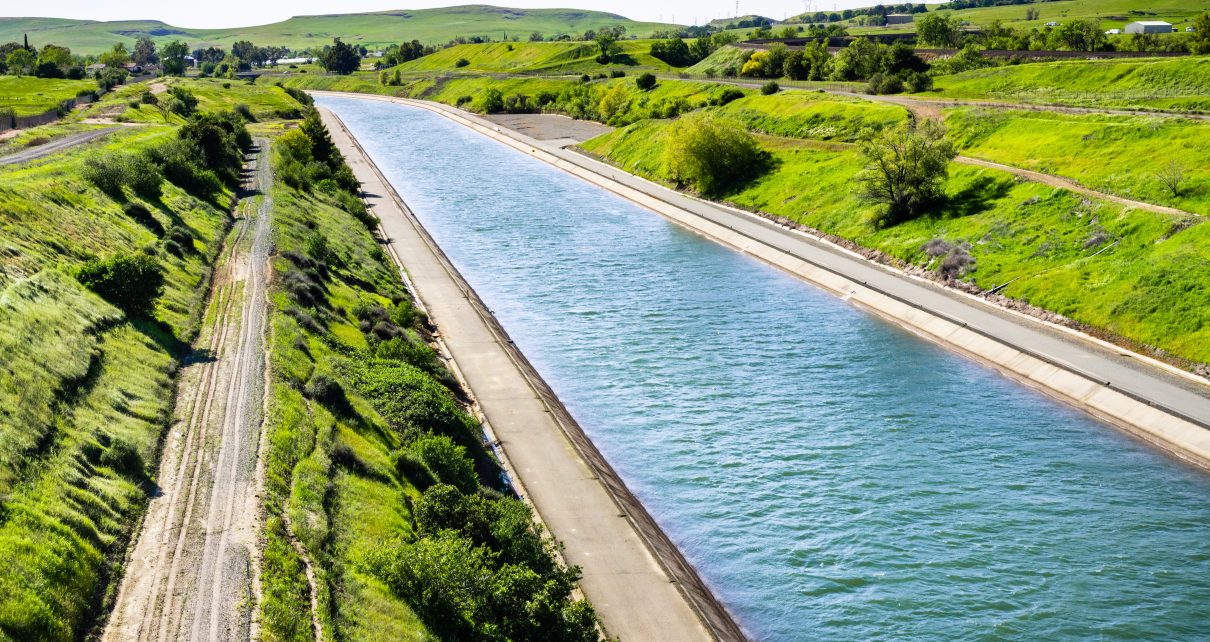
The Thermalito Power Canal in Oroville, Butte County. (Photo: Sundry Photography/Shutterstock)
The Abundance Choice, Part 8: The Union Factor
The power of environmentalists in California is literally strangling the state’s economy
By Edward Ring, May 28, 2022 2:22 am
The moment we met Robbie Hunter, then president of the State Building and Construction Trades Council, we knew we were in the presence of a man who does not lose. Assemblyman Devon Mathis had urged me to contact the construction unions before we finished our research to write the initiative and began an actual campaign, and through one of his mutual contacts, the meeting was arranged.
Three of us arrived at the SBCTC’s offices in downtown Sacramento back in August 2021, all of us dressed in our Sunday best; suits, ties, dress shoes. Hunter met us in their lobby, dressed like a man who does real work, wearing a t-shirt with a union logo on the front. As someone without experience meeting a union president, much less negotiating with one, Hunter, a burly man with a trace of an Irish accent, fit the stereotype I’d imagined. And that first meeting was encouraging.
We quickly learned that Hunter and his colleagues were very much in favor of more water infrastructure. They were interested in learning about our proposal and willing to assist with the language. Over the next several weeks we carefully included language that would protect the interests of this union, which has 450,000 members in California.
While nobody on our steering committee had any objection to us reaching out to work with a powerful private sector labor union, we had friends in the conservative community who were going to want an explanation. It wasn’t hard to provide one. All major state-funded major construction projects already use union labor. Why on Earth would we hesitate to guarantee to these unions various provisions that they already had? Our primary objective was to make sure our initiative language didn’t needlessly invite opposition from the construction unions.
All of us knew we were going to need support from construction unions, or at a minimum, neutrality. As we moved from the research phase of our initiative effort into the campaign to qualify it, we attempted to gather together representatives from the various interested parties to work together to support the initiative. There were three primary sources of possible support. The unions were one of those sources. And then there were the farmers.
We knew that California’s farmers could not be the only source of funding to qualify the initiative. Some of the big farmers were betting on scarce water to drive small farmers out of business so they could buy them out. We weren’t going to get any help from them. Other big farmers with the capacity to fund the whole qualification campaign were recognizing, probably accurately, that if they paid most of the money to qualify this, it would get branded as a giveaway to “big ag.” The small farmers, on the other hand, were already squeezed financially, trying to cover their fixed costs without enough water to grow crops on all their land.
The other source of potential support were the big construction contractors. With more time, we might have been able to reach out to more of them. With another dry year, we might have had them coming to us. But we knew that without at least three legs on the stool, the campaign would not have the support it needed. We contacted businesses in the San Francisco Bay Area and Southern California, pitching our idea to any of them that would give us the time. It is interesting to wonder how close we came, because in Sacramento, all of these interest groups – farmers, other business interests, and the unions – had lobbyists and trade representatives who talked to each other.
It was through our union contacts that we were introduced to one of the best polling firms in California, and we thought the polling results would help us. We learned that voter sentiment was overwhelmingly in favor of water infrastructure from almost every angle. Voters didn’t mind spending tax revenue on water supply projects. They ranked the drought and water scarcity as top issues of concern. The only area where the results were disappointing was in response to questions about the environment. Most voters in California will not support anything if they’re convinced it will harm the environment. And this was a dilemma. Because every expert we spoke with agreed that without some relief from California’s strict environmental laws, it won’t matter how much money voters approve for major water supply projects. They won’t get built.
And then it rained. The consensus based on the polling was that if we had a dry winter, this initiative would be approved by voters who would be frustrated by severe restrictions on water use through the summer and fall of 2022. But in December 2021, it rained. And rained. And rained. By the time the deluge subsided, people were headed into the Christmas holidays and focusing on family and vacation. While we redoubled our efforts in January, the momentum was lost and we ran out of time. We also ran out of rain, and we now know there is going to be a fourth year of drought.
But why wouldn’t the unions support our initiative? What factors prevented them, this time, from getting behind this project? When asked by Paul Rogers, reporting for the San Jose Mercury, Andrew Meredith, who succeeded Hunter as the SBCTC president in early 2022, said the campaign did not gather enough momentum. “We need to be diligent and ensure that our contributions translate to a net benefit for our members,” he said.
Meredith was making an understatement. While more major state-funded infrastructure projects would immediately and directly translate into more jobs for SBCTC members, for them to have supported our initiative would have constituted a declaration of war against many of the special interests they have historically fought beside.
In particular, the SBCTC would have gone up against the California Teachers Association and other powerful public sector unions representing state and local government workers, which would view allocating two percent of the state general fund to construction projects as taking money away from the programs that employ their members.
The SBCTC would have also had to stand up to the environmentalist lobby, which if anything is more powerful than the public sector unions. As we have seen, environmentalists in California are against almost all forms of land development or big civil engineering projects, and they attacked our campaign relentlessly for as long as we were active.
If taking on these two political superpowers weren’t enough, it’s worth asking whether the SBCTC really needed more jobs for their members. If their membership was at or near full employment, where would the tens of thousands of workers have come from to fill the jobs needed to construct off-stream reservoirs, repair aqueducts, and build wastewater recycling plants and the distribution pipes? One might see managing that membership growth as a tantalizing challenge, but perhaps too much trouble if it meant going to war with the public sector unions and the environmentalist community.
These realities put California’s high speed rail project into a revealing context. Very few competent analysts are left who are willing to claim this project will ever make economic or even environmental sense. It will be a drain on the economy and it is a deplorable waste of natural resources. It’s even destined for technological obsolescence, as high speed smart cars, car sharing, ride sharing, passenger drones, and remote work will obviate the need for high speed rail. But the high speed rail project was endorsed by environmentalists. With high speed rail, the union goal of providing jobs for their members was fulfilled without a war. It does not help California.
There is a larger question here for the unions, however, a bigger one than whether or not to have supported the now dormant Water Infrastructure Funding Act of 2022. When are unions going to stand up to environmentalists? And when are private sector unions going to stand up to public sector unions, with whom they have almost nothing in common, apart from the fact that they’re both called “unions”?
If the SBCTC, with 484,000 members, wanted to put our water initiative on the ballot, they could have done it themselves, at relatively low cost. They could have mailed the initiative petition to each of their more than 450,000 member households in California, instructing their members to seriously consider signing and returning the petition, preferably after getting some of their neighbors to also sign it. If this had been done, it is quite possible that they would have collected close to a million signatures with just a few direct mail efforts. And if they had done that, other players on the sidelines, the construction contractors and the farmers, would at that point have certainly joined the campaign.
The power of environmentalists in California is literally strangling the state’s economy. It is one of the primary reasons housing is unaffordable. It is the reason electricity and natural gas is so much more expensive here than in other states. It is the reason we can’t source our own lumber, gas and oil, fertilizer or aggregate right here within the state, and have to import most of it instead. It is the reason we are about shut down Diablo Canyon, a fully paid for sandiegouniontribune.com/…/possible-extension-for-states-last-nuclear-plant-draws-cheers-from-supporters-jeers-from-opponents source of cheap electricity. Environmentalist power is out of control in California, and private sector unions are one of the only forces in the state with the power to stand up to them, if they choose to do so.
The tendency in these discussions is to overstate each side of the case, so let’s pull back a bit. Nobody wants to destroy the natural environment in California. Nobody in their right mind isn’t grateful for environmentalist accomplishments, from phasing in unleaded gas and catalytic converters, to saving the California Condor. But environmentalists in California have succeeded, with the absolute complicity of the media and the education bureaucracy, in stigmatizing moderate views on environmental issues as extreme. There is nothing extreme about capturing runoff into a few more off-stream reservoirs, raising the height of the Shasta Dam, or, gasp, building one or two more desalination plants on the Southern California Coast. But to advocate these projects, or even to include them as we did as falling within project categories eligible for state funds, environmentalists did everything in their power to destroy our campaign.
The people running construction unions in California know better. They know that if you make it impossible, or nearly impossible, to build anything, the only people who benefit are the wealthiest owners and investors who control the limited and sanctioned means of production. You can put any label you wish on this model of political economy. Feudalism comes immediately to mind. But leave that to the intellectuals. For the workers on the street, what matters is the price of electricity, the price of natural gas, the price of gasoline, the price of housing, the price of food, and the price of water. And among those essentials, water is the enabling core. Water is life.
Our union friends can let California’s water become rationed and privatized, priced sky high to profit a small coterie of owners, and they can watch the ripple effect blow the roof off prices for every downstream essential including housing and food.
Or they can use their considerable power to help rein in environmentalist overreach, realign California politics, and save this great state for all working families.
- Ringside: Long Term Electricity Storage - July 23, 2025
- Ringside: One Way to Avoid Gasoline Lines in 2026 - July 18, 2025
- Ringside: Is California’s Water Infrastructure Ready for Climate Whiplash? - July 10, 2025








All of the installments of Edward Ring’s water series have been “must-reads” and here is another. For me the effect of reading it was to think about and fully appreciate California’s potential and how, but for these nearly immovable obstacles, how glorious life would be for everyone who lives and works here. Meanwhile, the possibility of it is so tantalizing it keeps us chipping away at the massive granite obstacles, no matter how difficult, slow, and painful. This record of the attempt is extremely valuable and will be useful when the hoped-for sea change comes that will begin to clear the way for the projects that California desperately needs. Fingers crossed.
Water policy positions are amongst my most important criteria for candidate selection purposes in the imminent June 7 primary election.
Because the CAGOP is useless except to bleat for cash, and has provided ZERO organization of Gubernatorial candidates, we have 37 Republicans to choose from on June 7.
I’m interested in Mr. Ring’s selection of the Republican candidate that will solve these vexing water problems.
I like Leo Zacky’s positions on,water, and as a Central Valley agri-businessman, believe he is amongst the best choices for California Governor, followed by Anthony Trimino.
Michael Shellenberger has captured most of the press, which instinctively tells me to avoid him, plus as a San Francisco “homeless advocate”, tells me that leopard can’t change his spots, and he will be another Trojan-horse Governor like Schwarzenegger.
Who should we vote for to fix California water management policy, Mr. Ring ( and Katy?)
Thank you…
CD9, it looks like Edward Ring likes Michael Shellenberger for Governor. See comment section at link below:
https://californiaglobe.com/articles/the-abundance-choice-part-6-biased-hostile-media/
Iconoclast Shellenberger has attracted the attention of conservatives (and others, of course) for a reason. His current positions, as well as his plans to address CA’s most pressing problems, are practical and do-able. He has researched (often hands-on) and thought his positions through. He doesn’t regurgitate the conventional stuff. His “conversion” from his progressive past strikes me as more of a strength than a deficit, for a number of reasons, one being that converts of all stripes tend to be more spirited and committed than life-long followers and have a fresh point of view. He is tough-minded but flexible in that he listens and learns and adapts. He also strikes me as a man of action. Bonus points to him for calling out Newsom like a champ. I also think he has the best chance of defeating Newsom, an important consideration.
Listen to this interview on the John Phillips Show KABC AM 790 as just one example and see what you think. It starts out slow but builds. 20 minutes:
https://omny.fm/shows/the-drive-home-with-jillian-barberie-and-john-ph-1/candidate-for-governor-michael-shellenberger
Thank you Showandtell… I missed that comment… and appreciate the link to KABC, too…. h/t
Thank YOU, CD9, for replying. Best wishes to you.